 In an astonishing volte-face, Sony Online Entertainment (SOE) has announced that it now endorses the auctioning of virtual items from its massively popular online game, Everquest II – with the electronics giant pocketing a cut of the cash, naturally.
In an astonishing volte-face, Sony Online Entertainment (SOE) has announced that it now endorses the auctioning of virtual items from its massively popular online game, Everquest II – with the electronics giant pocketing a cut of the cash, naturally.
From late June 2005, Sony’s Station Exchange will provide an “Online Entertainment auction service” enabling players to buy and sell virtual items for real money.
Sony is introducing the service in an attempt to put a halt to ‘plat farmers’. These are dastardly rotters who use macros and bots to harvest rare items in games, level up characters, gain virtual money – and then flog them off on eBay.
 Personally, we’d rather buy a round of lovely real ale than shell out for the Dark Lord of Deltronia’s Mystical Turbo Sword of Mwegneli, but as we’ve reported before (Sales in Virtual Goods Surpasses $100m, Nov 2004), considerable sums of money are changing hands for virtual items.
Personally, we’d rather buy a round of lovely real ale than shell out for the Dark Lord of Deltronia’s Mystical Turbo Sword of Mwegneli, but as we’ve reported before (Sales in Virtual Goods Surpasses $100m, Nov 2004), considerable sums of money are changing hands for virtual items.
SOE director John Smedley has estimated that the market for virtual items is upwards of US$200m (€153m/£104) worldwide and the Station Exchange looks to be an attempt to grab a fat slice of this juicy pie.
So far, Sony have said that the Station Exchange system will only be available on dedicated new servers and that players will be able to transfer to an exchange server but not from one.
Naturally, gaming bulletin boards have been buzzing with debate about this development, with some expressing concerns that the ability for a rich user to “buy” success in a game effectively creates a ‘class’ divide.
‘Miss Minnie’ voiced her doubts on the urban75 gaming forum:
 “There already is a ‘virtual class system’ within the game itself – you earn status and faction standing, money, prestige, titles, fancy clothes and transport, you start living in a hovel but can move on up to luxury apartments etc – But at least till now you could assume that most people had ‘earned’ those things by playing the game.
“There already is a ‘virtual class system’ within the game itself – you earn status and faction standing, money, prestige, titles, fancy clothes and transport, you start living in a hovel but can move on up to luxury apartments etc – But at least till now you could assume that most people had ‘earned’ those things by playing the game.
Now you won’t be sure if someone is a player or a buyer, so I suppose it could be said that touches of real-life’s ‘class system’ will be impinging.
In my opinion, that is the biggest shame – these games are supposed to be fantasy worlds and now real-life threatens to intrude.”
‘Private Storm’, on the same board, was more pragmatic:
“Trading of in-game items etc goes on and it is extremely difficult to stop it.”
 “I’m not sure of the mechanics in EQII, but in WoW (World of Warcraft) they have mitigated the potential for selling items somewhat by introducing the concept of having things bind to that character when it is picked up, meaning you can’t transfer items to other players, hence no selling though eBay and the like.”
“I’m not sure of the mechanics in EQII, but in WoW (World of Warcraft) they have mitigated the potential for selling items somewhat by introducing the concept of having things bind to that character when it is picked up, meaning you can’t transfer items to other players, hence no selling though eBay and the like.”
“I think Sony has said in their press release that they can’t ignore the fact that the selling of stuff goes on and that a lot of the support they have to give players is to do with this, so they’re creating controlled systems for it to happen. Virtual ‘harm reduction’ as it were.”
“People approach these types of game with different playing styles and with different things they want to get out of it. Such games often require a large amount of time and dedication to actually see any significant progression and not everyone has the time to realise this progress. If you are a cash rich, but time poor player, but still want to play the game, buying items etc to help you get the most out of your time online doesn’t seem so bad.”
“On the other hand, there are players that are time rich, but cash poor who can achieve a large amount of success within the game simply ‘cos they have the time to do so. They’ve invested a large amount of time and money in playing the game and obviously feel that they should be able to benefit in the real world from this. Selling the stuff they acquire seems reasonable in this context.”
 For some gamers, an officially sanctioned auction site is an inevitable consequence of the growing popularity of virtual gaming, with Sony’s cut, a reasonable price to pay for eliminating a lot of scams.
For some gamers, an officially sanctioned auction site is an inevitable consequence of the growing popularity of virtual gaming, with Sony’s cut, a reasonable price to pay for eliminating a lot of scams.
If Station Exchange is successful, it may only be a matter of time before other auctions are permitted for SOE’s other games like Everquest I and Star Wars Galaxies.
Perhaps an official virtual auction site might prevent further tragedies like this story we covered last month: Legend of Mir 3 Gamer Killed After Selling Virtual Sword
Sony Station Exchange
urban75 bulletin boards
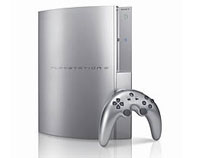 Games:
Games: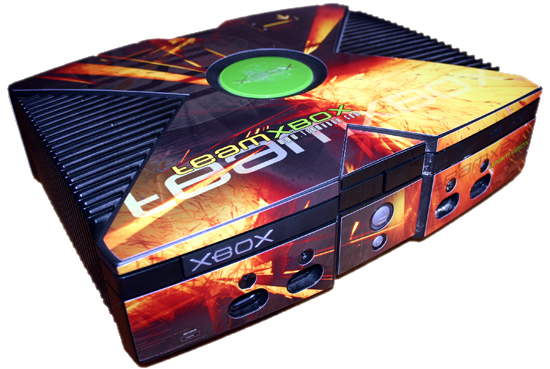 I don’t currently own an Xbox, but I have been quite a fan of Sony’s Playstation for a while: I had two of the original Playstations, PS1 and PS2 for various reasons. You might’ve thought that I would’ve been looking forward to the The Worst Foods To Eat Over A Keyboard
I don’t currently own an Xbox, but I have been quite a fan of Sony’s Playstation for a while: I had two of the original Playstations, PS1 and PS2 for various reasons. You might’ve thought that I would’ve been looking forward to the The Worst Foods To Eat Over A Keyboard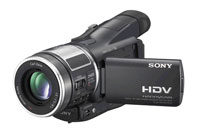 Pausing briefly for breath after announcing the new PlayStation today, the busy bees in the Sony hive have announced the world’s smallest and lightest high definition consumer camcorder with full HD resolution based on HDV 1080i.
Pausing briefly for breath after announcing the new PlayStation today, the busy bees in the Sony hive have announced the world’s smallest and lightest high definition consumer camcorder with full HD resolution based on HDV 1080i.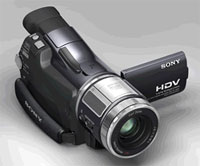 The new camera also uses a smaller and more compact Carl Zeiss lens, with a diameter of 60mm compared to 92 mm on the previous model.
The new camera also uses a smaller and more compact Carl Zeiss lens, with a diameter of 60mm compared to 92 mm on the previous model.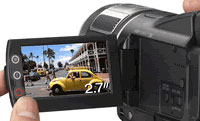 A Memory Stick PRO Duo media slot is provided for transferring images captured on the camcorder’s 2.8-megapixel still camera.
A Memory Stick PRO Duo media slot is provided for transferring images captured on the camcorder’s 2.8-megapixel still camera.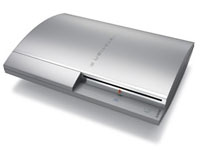 Sony are currently collaborating with the world’s leading tools and middleware companies, to provide developers with extensive tools and libraries to make the best of the Cell processor and enable efficient software development.
Sony are currently collaborating with the world’s leading tools and middleware companies, to provide developers with extensive tools and libraries to make the best of the Cell processor and enable efficient software development.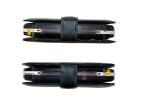 Games developers have included Internet access in their products. The best example of this is Wipeout Pure, which includes a browser, allowing the user to download new game levels and features. Since the game has a browser built-in, it can be reasonable to assume that Sony have actually put all the code to access the Internet in the PSP itself (and made it available to developers).
Games developers have included Internet access in their products. The best example of this is Wipeout Pure, which includes a browser, allowing the user to download new game levels and features. Since the game has a browser built-in, it can be reasonable to assume that Sony have actually put all the code to access the Internet in the PSP itself (and made it available to developers). Rather than everyone set-up spoof servers, some nice people have done it for you, and these then point to a PSP portal which someone has set-up PSP friendly content. You can access the spoof DNS servers by amending your Internet set-up configuration (on the PSP) and leave everything to automatic except for the DNS settings, into which you enter the spoof server settings.
Rather than everyone set-up spoof servers, some nice people have done it for you, and these then point to a PSP portal which someone has set-up PSP friendly content. You can access the spoof DNS servers by amending your Internet set-up configuration (on the PSP) and leave everything to automatic except for the DNS settings, into which you enter the spoof server settings. Once updated versions of the firmware come out, or there are 3rd party applications, the system will have all the features to be a powerful media hub. It supports WiFi, has a decent screen and video capability now, adding other Internet capabilities will just add the finishing touches to a superb product.
Once updated versions of the firmware come out, or there are 3rd party applications, the system will have all the features to be a powerful media hub. It supports WiFi, has a decent screen and video capability now, adding other Internet capabilities will just add the finishing touches to a superb product. Sony have produced a portable games console which on its own merit is going to sell a lot of units. However it has the possibility of becoming a portable media hub that will give even Microsoft a jolt by driving into their Portable Media Center market.
Sony have produced a portable games console which on its own merit is going to sell a lot of units. However it has the possibility of becoming a portable media hub that will give even Microsoft a jolt by driving into their Portable Media Center market. The system uses Sony’s 1.8″ UMD optical disk which comes in a protective sheath (like a minidisc). They’re small enough so you could easily carry a few around with you (though don’t eject them unless there’s something solid and accessible beneath you as they have a tendency to fly out and disappear somewhere awkward). There’s also a Memory Stick due (32MB supplied) to allow game saves and other features.
The system uses Sony’s 1.8″ UMD optical disk which comes in a protective sheath (like a minidisc). They’re small enough so you could easily carry a few around with you (though don’t eject them unless there’s something solid and accessible beneath you as they have a tendency to fly out and disappear somewhere awkward). There’s also a Memory Stick due (32MB supplied) to allow game saves and other features. The system looks like a USB memory device when attached to a PC (which basically gives access to the Memory Stick) and you can store audio and video on it. Sensibly, Sony support MP3 directly on the PSP, though it will also support ATRACplus encoded music. Interestingly, if someone decides to produce UMD music disks, they only support ATRACplus and linear PCM). Video is H.264/MPEG-4 AVC on the UMD and MPEG-4 SP, AAC on the memory stick.
The system looks like a USB memory device when attached to a PC (which basically gives access to the Memory Stick) and you can store audio and video on it. Sensibly, Sony support MP3 directly on the PSP, though it will also support ATRACplus encoded music. Interestingly, if someone decides to produce UMD music disks, they only support ATRACplus and linear PCM). Video is H.264/MPEG-4 AVC on the UMD and MPEG-4 SP, AAC on the memory stick. Once the PSP has real Internet capability it will be a media powerhouse, the screen size is about right for watching movies on the go. You could do this now by converting a current MPEG-2 (DVD) to MPEG-4 and storing it on the memory stick (ignoring all legal ramifications), but in future it’s more than likely you’ll be able to stream movies (or audio) directly to the unit. Sony as a music publisher and movie house, is likely to want to sell its content to a market of portable viewers – it owns both ends of the stick.
Once the PSP has real Internet capability it will be a media powerhouse, the screen size is about right for watching movies on the go. You could do this now by converting a current MPEG-2 (DVD) to MPEG-4 and storing it on the memory stick (ignoring all legal ramifications), but in future it’s more than likely you’ll be able to stream movies (or audio) directly to the unit. Sony as a music publisher and movie house, is likely to want to sell its content to a market of portable viewers – it owns both ends of the stick. As the number of digital TV-enabled households continues to rise and the
As the number of digital TV-enabled households continues to rise and the 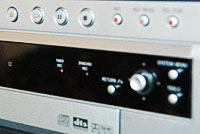 The unit’s onscreen interface is simplicity itself, with the eight-day electronic programme guide (EPG) banishing those video timer nightmares forever – this puppy is so simple, even a granny overdosed on Christmas sherry would have no problem setting up a recording of Des and Mel.
The unit’s onscreen interface is simplicity itself, with the eight-day electronic programme guide (EPG) banishing those video timer nightmares forever – this puppy is so simple, even a granny overdosed on Christmas sherry would have no problem setting up a recording of Des and Mel.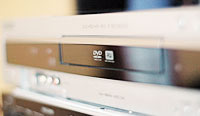 A range of recording quality modes let you increase recording time at the expense of image quality.
A range of recording quality modes let you increase recording time at the expense of image quality.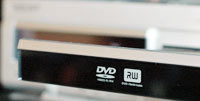 Highly recommended
Highly recommended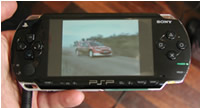 Big sighs of disappointment are heard all around Europe, as Sony officially announce the released date of the handheld gaming/media dream machine, the Sony PSP. It’s going to be 1 September 2005.
Big sighs of disappointment are heard all around Europe, as Sony officially announce the released date of the handheld gaming/media dream machine, the Sony PSP. It’s going to be 1 September 2005. Sony have announced the PlayStation Portable Value Pack at €249 (£179/US$323), which includes headphones, a 32Mb Memory Stick Duo, power supply, protective pouch, etc. The hit film Spider-Man 2 will be available on a UMD disc, free to early purchasers of PSP when they register on YourPSP.com.
Sony have announced the PlayStation Portable Value Pack at €249 (£179/US$323), which includes headphones, a 32Mb Memory Stick Duo, power supply, protective pouch, etc. The hit film Spider-Man 2 will be available on a UMD disc, free to early purchasers of PSP when they register on YourPSP.com.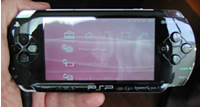 There are many tales of PSP-owners modifying their pride and joy to browser the Internet via Wi-Fi, or indeed run Instant Messaging client software.
There are many tales of PSP-owners modifying their pride and joy to browser the Internet via Wi-Fi, or indeed run Instant Messaging client software. Ericsson has reported a thumping great rise in quarterly profits, helped by the deployment of 3G networks.
Ericsson has reported a thumping great rise in quarterly profits, helped by the deployment of 3G networks.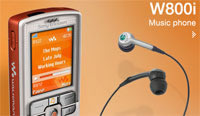 These figures fly in the face of predictions from investors and analysts that sales would drop steadily for the big telecoms firms as Chinese manufacturers took over the industry.
These figures fly in the face of predictions from investors and analysts that sales would drop steadily for the big telecoms firms as Chinese manufacturers took over the industry.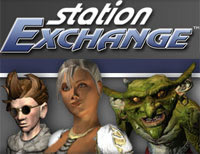 In an astonishing volte-face, Sony Online Entertainment (SOE) has announced that it now endorses the auctioning of virtual items from its massively popular online game, Everquest II – with the electronics giant pocketing a cut of the cash, naturally.
In an astonishing volte-face, Sony Online Entertainment (SOE) has announced that it now endorses the auctioning of virtual items from its massively popular online game, Everquest II – with the electronics giant pocketing a cut of the cash, naturally. Personally, we’d rather buy a round of lovely real ale than shell out for the Dark Lord of Deltronia’s Mystical Turbo Sword of Mwegneli, but as we’ve reported before (
Personally, we’d rather buy a round of lovely real ale than shell out for the Dark Lord of Deltronia’s Mystical Turbo Sword of Mwegneli, but as we’ve reported before ( “There already is a ‘virtual class system’ within the game itself – you earn status and faction standing, money, prestige, titles, fancy clothes and transport, you start living in a hovel but can move on up to luxury apartments etc – But at least till now you could assume that most people had ‘earned’ those things by playing the game.
“There already is a ‘virtual class system’ within the game itself – you earn status and faction standing, money, prestige, titles, fancy clothes and transport, you start living in a hovel but can move on up to luxury apartments etc – But at least till now you could assume that most people had ‘earned’ those things by playing the game.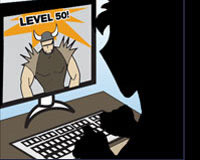 “I’m not sure of the mechanics in EQII, but in WoW (World of Warcraft) they have mitigated the potential for selling items somewhat by introducing the concept of having things bind to that character when it is picked up, meaning you can’t transfer items to other players, hence no selling though eBay and the like.”
“I’m not sure of the mechanics in EQII, but in WoW (World of Warcraft) they have mitigated the potential for selling items somewhat by introducing the concept of having things bind to that character when it is picked up, meaning you can’t transfer items to other players, hence no selling though eBay and the like.” For some gamers, an officially sanctioned auction site is an inevitable consequence of the growing popularity of virtual gaming, with Sony’s cut, a reasonable price to pay for eliminating a lot of scams.
For some gamers, an officially sanctioned auction site is an inevitable consequence of the growing popularity of virtual gaming, with Sony’s cut, a reasonable price to pay for eliminating a lot of scams. After years of throwing pans at each other, Sony and Toshiba are set to kiss and make up and develop a universal standard for next-generation DVDs, according to a report in the Nihon Keizai Shimbun business daily.
After years of throwing pans at each other, Sony and Toshiba are set to kiss and make up and develop a universal standard for next-generation DVDs, according to a report in the Nihon Keizai Shimbun business daily. Two competing formats developed out of this technology, with Sony and Matsushita (Panasonic), introducing the Blu-ray standard in February 2002, with Toshiba and NEC Corp. following with the HD DVD standard.
Two competing formats developed out of this technology, with Sony and Matsushita (Panasonic), introducing the Blu-ray standard in February 2002, with Toshiba and NEC Corp. following with the HD DVD standard.